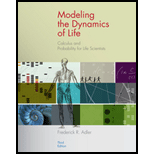
To find: The ratio of the volume of the larger tree to that of the smaller tree.
Answer to Problem 30E
The ratio of the volume of the larger tree to that of the smaller tree is 1.069.
Explanation of Solution
Given information:
The height of the first tree is
Formula used:
The volume of a cylinder is
The volume of a sphere is
Calculation:
The height of the first tree is
The height of the second tree is
The radius of both trees is
The volume of a cylinder is
Where,
The volume of a sphere is
Where
The 90% of the height of the first tree is a cylindrical trunk. Therefore,
Hence, the volume
Since 10% of the height of the tree is a spherical blob, we get
Therefore, the radius of the sphere is as follows
So, the volume of the spherical blob part of the first tree is shown below
Therefore, the volume of the first tree is
Since half of the height of the tree is a cylindrical trunk, we find that
The volume of cylindrical part of the second tree is shown below
Since half of the height of the tree is spherical blob, So
Therefore the radius of sphere can be calculate as
The volume of the second tree with half of the height in the spherical blob is
The volume of the second tree is
Since
The ratio is
Hence, the ratio
Want to see more full solutions like this?
Chapter 1 Solutions
Modeling the Dynamics of Life: Calculus and Probability for Life Scientists
- Refer to page 52 for solving the heat equation using separation of variables. Instructions: • • • Write the heat equation in its standard form and apply boundary and initial conditions. Use the method of separation of variables to derive the solution. Clearly show the derivation of eigenfunctions and coefficients. Provide a detailed solution, step- by-step. Link: [https://drive.google.com/file/d/1wKSrun-GlxirS31Z9qo Hazb9tC440AZF/view?usp=sharing]arrow_forwardRefer to page 20 for orthogonalizing a set of vectors using the Gram-Schmidt process. Instructions: • Apply the Gram-Schmidt procedure to the given set of vectors, showing all projections and subtractions step-by-step. • Normalize the resulting orthogonal vectors if required. • Verify orthogonality by computing dot products between the vectors. Link: [https://drive.google.com/file/d/1wKSrun-GlxirS3IZ9qoHazb9tC440AZF/view?usp=sharing]arrow_forwardRefer to page 54 for solving the wave equation. Instructions: • Apply d'Alembert's solution method or separation of variables as appropriate. • Clearly show the derivation of the general solution. • Incorporate initial and boundary conditions to obtain a specific solution. Justify all transformations and integrations. Link: [https://drive.google.com/file/d/1wKSrun-GlxirS31Z9qo Hazb9tC440AZF/view?usp=sharing]arrow_forward
- Refer to page 14 for calculating eigenvalues and eigenvectors of a matrix. Instructions: • Compute the characteristic polynomial by finding the determinant of A - XI. • Solve for eigenvalues and substitute them into (A - I) x = 0 to find the eigenvectors. • Normalize the eigenvectors if required and verify your results. Link: [https://drive.google.com/file/d/1wKSrun-GlxirS3IZ9qoHazb9tC440 AZF/view?usp=sharing]arrow_forwardExilet x = {a,b.c}dex.x―R> d(a,b) = d(b, c)=1' d(a, c) = 2 d(xx)=0VXEX is (x.d) m.s or not? 3.4 let x= d ((x,y), (3arrow_forwardHiw Show that sup (0,1) = 1 الفصل الثاني * Dif: let {an} be Seq. then fan?arrow_forward
- Please show as much work as possible to clearly show the steps you used to find each solution. If you plan to use a calculator, please be sure to clearly indicate your strategy. 1. The probability of a soccer game in a particular league going into overtime is 0.125. Find the following: a. The odds in favour of a game going into overtime. b. The odds in favour of a game not going into overtime. c. If the teams in the league play 100 games in a season, about how many games would you expect to go into overtime?arrow_forwardThe probability of being born in a particular month is about 1:12. Determine the probability of not being born in September. Express this ratio as a fraction, a decimal, a percent and in words.arrow_forwardIn his first hockey game of the season, Brayden takes a total of 10 shots on the goalie and scores 1 time. Later in the season, he takes 30 shots in total on the goalie. How many goals would you expect him to make? What assumptions are making? Are your assumptions realistic? Explain.arrow_forward
- The probability of being born in a particular month is about 1:12. Determine the probability of not being born in September. Express this ratio as a fraction, a decimal, a percent and in words.arrow_forwardThe probability of being born in a particular month is about 1:12. Determine the probability of not being born in September. Express this ratio as a fraction, a decimal, a percent and in words.arrow_forwardDevon is expected to receive 70% of the votes at the student council election. If there are 650 students in his school, how many are expected to vote for him?arrow_forward
 Mathematics For Machine TechnologyAdvanced MathISBN:9781337798310Author:Peterson, John.Publisher:Cengage Learning,
Mathematics For Machine TechnologyAdvanced MathISBN:9781337798310Author:Peterson, John.Publisher:Cengage Learning, Elementary Geometry For College Students, 7eGeometryISBN:9781337614085Author:Alexander, Daniel C.; Koeberlein, Geralyn M.Publisher:Cengage,
Elementary Geometry For College Students, 7eGeometryISBN:9781337614085Author:Alexander, Daniel C.; Koeberlein, Geralyn M.Publisher:Cengage, Holt Mcdougal Larson Pre-algebra: Student Edition...AlgebraISBN:9780547587776Author:HOLT MCDOUGALPublisher:HOLT MCDOUGAL
Holt Mcdougal Larson Pre-algebra: Student Edition...AlgebraISBN:9780547587776Author:HOLT MCDOUGALPublisher:HOLT MCDOUGAL Trigonometry (MindTap Course List)TrigonometryISBN:9781305652224Author:Charles P. McKeague, Mark D. TurnerPublisher:Cengage Learning
Trigonometry (MindTap Course List)TrigonometryISBN:9781305652224Author:Charles P. McKeague, Mark D. TurnerPublisher:Cengage Learning Algebra: Structure And Method, Book 1AlgebraISBN:9780395977224Author:Richard G. Brown, Mary P. Dolciani, Robert H. Sorgenfrey, William L. ColePublisher:McDougal Littell
Algebra: Structure And Method, Book 1AlgebraISBN:9780395977224Author:Richard G. Brown, Mary P. Dolciani, Robert H. Sorgenfrey, William L. ColePublisher:McDougal Littell Elementary Geometry for College StudentsGeometryISBN:9781285195698Author:Daniel C. Alexander, Geralyn M. KoeberleinPublisher:Cengage Learning
Elementary Geometry for College StudentsGeometryISBN:9781285195698Author:Daniel C. Alexander, Geralyn M. KoeberleinPublisher:Cengage Learning





